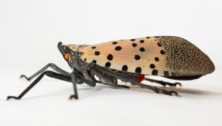Pennsylvania Liquor Control Board Funds Study of Spotted Lanternfly Effect on Cabernet Franc Grapes

Pennsylvania Liquor Control Board has approved a grant for Penn State to study the effects of the spotted lanternfly on cabernet franc, the grape variety that is usually blended with Merlot and Cabernet Sauvignon wines, writes Kiley Koscinski for WHYY.
Penn State Extension has been studying the negative impacts of the pest since it first arrived in Pennsylvania from native Asia seven years ago. During that time, researchers determined that the insect feeds on several economically important crops, including cucumbers, hardwoods, ornamentals — and grapes.
The invasive pest has caused serious damage to the state’s vineyards. It has reduced starch concentrations in vine roots, lowered crop yields, and increased susceptibility to frost damage.
In the most severe infestations, vines simply wither and die.
The grant provides Penn State with more than $100,000 to continue studying how to best manage and suppress the insect’s population close to vineyards.
The funding is one of 13 grants, totaling $1.9 million, approved by Pennsylvania Liquor Control Board for different projects in the Keystone State’s wine, beer, and cider industries.
More about the spotted lanternfly and vineyard health is at WHYY.
Connect With Your Community
Subscribe for stories that matter!
"*" indicates required fields





























